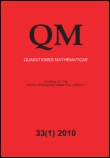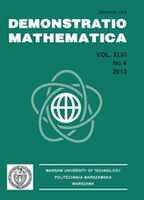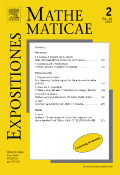
Journal of Mathematical Analysis
Scope & Guideline
Navigating the Landscape of Advanced Mathematics
Introduction
Aims and Scopes
- Operator Theory:
A core focus of the journal is operator theory, which includes studies on bounded and unbounded operators, spectral theory, and various classes of operators such as Toeplitz and composition operators. - Functional Analysis:
The journal places significant emphasis on functional analysis, exploring topics such as Banach spaces, Hilbert spaces, and the properties of functional spaces, which are critical for understanding more complex mathematical structures. - Dynamical Systems:
Research on dynamical systems, including stochastic and deterministic systems, is a prominent area of publication. This encompasses the study of stability, attractors, and behaviors of systems governed by differential equations. - Interpolation Theory:
The journal frequently publishes papers on interpolation theory, focusing on various interpolation spaces and techniques, which are essential for connecting different areas of mathematical analysis. - Nonlinear Analysis:
Nonlinear analysis, particularly in the context of differential equations and variational problems, is another significant area of interest, showcasing the journal's commitment to advancing the understanding of complex mathematical phenomena. - Approximation Theory:
The journal also covers approximation theory, including the development of methods for approximating functions and operators, which is vital for both theoretical and applied mathematics.
Trending and Emerging
- Stochastic Analysis:
There has been a significant increase in research focused on stochastic processes and stochastic differential equations. This trend highlights the growing interest in understanding random phenomena and their applications in various fields. - Operator Algebras:
The study of operator algebras, particularly C*-algebras and von Neumann algebras, is increasingly prominent, reflecting a trend towards abstract algebraic structures and their applications in analysis. - Nonlinear Functional Analysis:
Research exploring nonlinear aspects of functional analysis, including nonlinear operators and equations, is on the rise, indicating a shift towards more complex analytical problems. - Fractional Calculus:
The emerging interest in fractional calculus, which deals with derivatives and integrals of non-integer orders, is gaining popularity, showcasing its applications in various mathematical and physical contexts. - Wavelet and Frame Theory:
The use of wavelets and frames in analysis and signal processing is becoming more prevalent, demonstrating the journal's commitment to interdisciplinary research that bridges mathematical theory and practical applications. - Quantum Analysis:
An emerging theme is the intersection of analysis with quantum theory, particularly in the context of quantum mechanics and quantum information, reflecting the journal's engagement with contemporary scientific challenges.
Declining or Waning
- Classical Analysis:
There has been a noticeable decrease in publications focused solely on classical analysis topics, such as basic real and complex analysis, as the field increasingly shifts towards more abstract and applied areas. - Discrete Analysis:
Research concerning discrete analysis, including combinatorial aspects and finite-dimensional spaces, appears to be less frequently represented in recent publications, indicating a trend towards continuous and infinite-dimensional analysis. - Elementary Functional Analysis:
Basic topics in functional analysis, such as foundational results and classical theorems, have seen a reduction in focus as researchers explore more advanced and specialized areas of the field. - Geometric Analysis:
Themes related to geometric analysis, which traditionally included studies on geometric properties of spaces and manifolds, are less prevalent, possibly overshadowed by more algebraic and topological approaches.
Similar Journals

Quaestiones Mathematicae
Cultivating a Legacy of Mathematical ExcellenceQuaestiones Mathematicae is a distinguished academic journal dedicated to the field of mathematics, published by Taylor & Francis Ltd, a renowned name in scholarly publishing. Established in 1976, this journal has been a critical resource for researchers, professionals, and students alike, providing a platform for innovative and rigorous advancements in miscellaneous mathematics. The journal holds a 2023 Scopus rank of 35 out of 90 in its category, reflecting its significant contribution to the field with a 61st percentile standing, and whilst it is categorized in the Q3 quartile, it remains an essential avenue for sharing pivotal mathematical research. Although not open access, Quaestiones Mathematicae offers a rich archive of acclaimed papers, encouraging scholarly dialogue and fostering the growth of mathematical knowledge. With a converged span extending to 2024, it continues to evolve and adapt, ensuring its relevance and impact within the global academic community.

JOURNAL OF FUNCTIONAL ANALYSIS
Elevating Functional Analysis to New HeightsThe JOURNAL OF FUNCTIONAL ANALYSIS, published by Academic Press Inc Elsevier Science, stands as a premier platform in the field of analysis, encompassing a broad spectrum of topics pertinent to functional analysis and its applications. With an impressive impact factor and categorized in Q1 for the year 2023, it ranks as one of the top journals in Mathematics (Analysis), placing it in the 77th percentile among its peers. This journal, founded in 1967, continues to provide researchers, professionals, and students with cutting-edge insights, rigorous publications, and a vibrant forum for scholarly discourse. The journal remains committed to advancing knowledge in the discipline and fostering an environment that encourages innovation and collaboration. Although it does not offer open access options, its high standards for publication ensure that each issue is replete with high-quality research that significantly contributes to the field. The journal's comprehensive coverage aligns well with the evolving landscape of functional analysis, making it an indispensable resource for anyone seeking to deepen their understanding and engage with current trends in this essential area of mathematics.

St Petersburg Mathematical Journal
Connecting Minds through Cutting-edge Mathematical ResearchSt Petersburg Mathematical Journal, published by the American Mathematical Society, is a distinguished platform that fosters research and discourse in the fields of mathematics, specifically focusing on Algebra and Number Theory, Analysis, and Applied Mathematics. With an ISSN of 1061-0022 and an E-ISSN of 1547-7371, this journal has been a reliable source of cutting-edge mathematical research since its inception in 2003 and continues to publish high-quality content through 2024. Although not open-access, it offers valuable insights and advances the mathematical community's understanding, as indicated by its respectable impact factor and Scopus rankings across various categories—landing in the Q3 quartile across three significant mathematical disciplines. Researchers, professionals, and students are encouraged to contribute and engage with this journal, as it remains a vital resource for promoting collaboration and discovery within the ever-evolving field of mathematics.

Demonstratio Mathematica
Connecting Scholars Through Mathematical ExcellenceDemonstratio Mathematica, published by DE GRUYTER POLAND SP Z O O, is an esteemed open-access journal in the field of mathematics, with an ISSN of 0420-1213 and E-ISSN 2391-4661. Established in 1996 and providing open access since 2009, it has become a vital platform for disseminating innovative research and advancements in various areas of mathematics. With a commendable Scopus ranking of 85/399 in General Mathematics and a 2023 Category Quartile of Q2, it stands at the forefront of the mathematical community, demonstrating a significant impact within the top 78th percentile. The journal aims to foster a deeper understanding and appreciation of mathematical concepts and their applications, catering to both seasoned researchers and emerging scholars. Located in Warsaw, Poland, Demonstratio Mathematica not only enriches the academic discourse but also strengthens collaborative efforts within the international mathematics community, making it an essential resource for those seeking to expand their knowledge and research output.

ZEITSCHRIFT FUR ANALYSIS UND IHRE ANWENDUNGEN
Connecting Scholars to the Heart of Mathematical AnalysisZEITSCHRIFT FUR ANALYSIS UND IHRE ANWENDUNGEN, published by the European Mathematical Society, stands as a vital resource in the fields of analysis and applied mathematics. With an ISSN of 0232-2064 and E-ISSN 1661-4534, this esteemed journal has been disseminating high-quality research since its inception in 1996, converging its efforts through 2024. Recognized within Q2 quartiles of both analysis and applied mathematics categories, it ranks #98 out of 193 in Mathematics _ Analysis and #379 out of 635 in Mathematics _ Applied Mathematics according to Scopus, affirming its significant impact within the academic community. Although not open access, the journal provides a platform for rigorous peer-reviewed articles that foster the interplay between theoretical insights and practical applications, catering to the needs of researchers, professionals, and students alike. With its editorial board comprised of leading experts, ZEITSCHRIFT FUR ANALYSIS UND IHRE ANWENDUNGEN continues to advance mathematical knowledge, making it an essential journal for those aiming to stay at the forefront of analysis and its applications.

Eurasian Mathematical Journal
Championing Open Access to Mathematical Knowledge.Welcome to the Eurasian Mathematical Journal, a prominent platform dedicated to advancing the field of mathematics, particularly in its miscellaneous applications. Published by the esteemed L N Gumilyov Eurasian National University in Kazakhstan, this journal has been serving the academic community since 2014. With an ISSN of 2077-9879, it has successfully carved its niche within the mathematical landscape, presently ranked Q2 and placing in the 64th percentile among general mathematics publications in Scopus. The journal aims to foster scholarly exchange through high-quality research articles, reviews, and theoretical advancements that enhance understanding and application of mathematical concepts. By prioritizing open accessibility and a rigorous peer-review process, the Eurasian Mathematical Journal contributes significantly to both theoretical exploration and practical innovation, making it an essential resource for researchers, professionals, and students alike.

Dissertationes Mathematicae
Championing Excellence in Mathematical Scholarship.Dissertationes Mathematicae is a prestigious academic journal published by the Polish Academy of Sciences Institute of Mathematics (IMPan), renowned for its contributions to the field of mathematics since its inception. With an impressive Q1 ranking in the miscellaneous mathematics category for 2023 and positioned at Rank #73 out of 399 in General Mathematics according to Scopus, this journal serves as a pivotal platform for disseminating high-quality research and innovative theoretical developments. Spanning from 2000 to 2024, it focuses on a broad range of mathematical disciplines, encouraging interdisciplinary collaboration and advancing mathematical understanding globally. While it currently does not offer open access, the journal is highly regarded in academic circles and continues to attract submissions from respected researchers and institutions. With a commitment to excellence and a notable impact factor, Dissertationes Mathematicae plays a crucial role in the ongoing development of mathematical theories and applications, making it an essential resource for researchers, professionals, and students alike.

CZECHOSLOVAK MATHEMATICAL JOURNAL
Bridging Concepts, Building KnowledgeCzechoslovak Mathematical Journal is a distinguished academic journal published by Springer Heidelberg, dedicated to advancing the field of mathematics through the dissemination of high-quality research. With an ISSN of 0011-4642 and E-ISSN 1572-9141, this journal has been a pivotal platform for mathematicians and researchers from around the globe since its inception. The journal holds a Q3 ranking in the field of Mathematics (miscellaneous), demonstrating its commitment to providing a forum for the latest mathematical theories and applications, particularly in general mathematics, as indicated by its Scopus rank of #285/399 and 28th percentile in the field. While currently not offering open access options, the journal continues to attract a wide readership by making its valuable content available through traditional subscription models. The Czechoslovak Mathematical Journal serves as an essential resource for researchers, professionals, and students aiming to stay informed about recent developments and breakthroughs in mathematics, with focus years converging from 1995 to 2024.

EXPOSITIONES MATHEMATICAE
Advancing Mathematical Frontiers with Rigorous ResearchEXPOSITIONES MATHEMATICAE, published by Elsevier GmbH, stands as a significant journal in the realm of mathematics, catering primarily to researchers, professionals, and students. With an ISSN of 0723-0869 and an E-ISSN of 1878-0792, this journal has made its mark in the academic community, boasting a Q2 classification in the miscellaneous mathematics category for 2023, illustrating its prominence within its field. The journal addresses a diverse scope of mathematical topics, encouraging the publication of original research and innovative theories while maintaining rigorous academic standards. As it converges from 2004 to 2024, EXPOSITIONES MATHEMATICAE continues to be an essential resource for advancing mathematical knowledge and fostering scholarly communication, despite being a non-open-access publication. Its location in Munich, Germany further anchors it within a rich intellectual tradition, providing accessibility for the mathematical community worldwide.

PUBLICATIONES MATHEMATICAE DEBRECEN
Exploring the Depths of Mathematical InquiryPublicationes Mathematicae Debrecen is a renowned international journal published by the University of Debrecen, Institute of Mathematics, situated in Hungary. This journal, with both ISSN 0033-3883 and E-ISSN 2064-2849, has established itself in the field of mathematics since its inception, with coverage extending from 1997 to 2024. Recognized for its rigorous academic standards, it currently holds a Q3 ranking in the mathematics (miscellaneous) category for 2023 and ranks at the 42nd percentile among general mathematics journals in Scopus. Publicationes Mathematicae Debrecen aims to disseminate high-quality research across various areas of mathematics, contributing to the advancement of knowledge and practice in this dynamic field. Although it is not an open-access journal, its readers can access a wealth of scholarly work that addresses both theoretical and applied mathematical issues, making it an invaluable resource for researchers, professionals, and students alike.